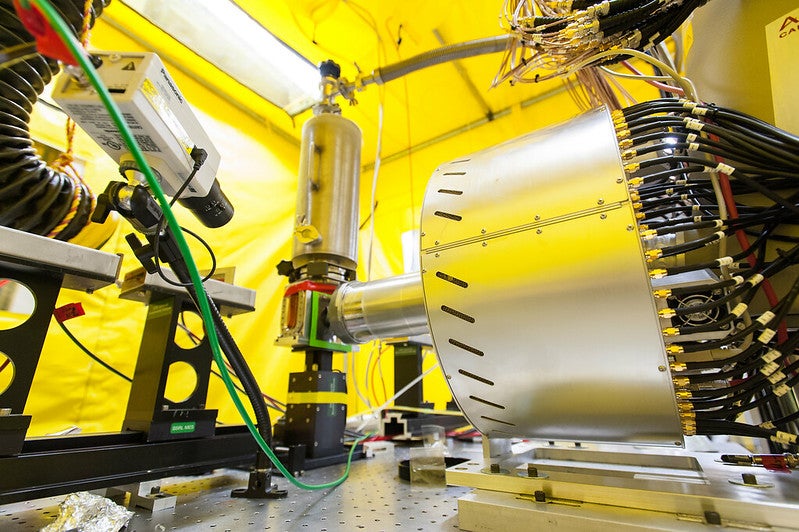Overview
Beam line 11-2 is a high-flux XAS end-station dedicated to radiological, geochemical, and surface/interfacial science. It is optimized for challenging XAS measurements on dilute or radioactive samples, surfaces, and interfaces. To support these experiments, BL11-2 is equipped with collimating and focusing optics, a "double double" Si(220) LN2-cooled monochromator, and a 100-pixel monolithic solid state Ge detector array. Additional instrumentation includes LHe and LN2 cryostats, a grazing incidence XAS spectrometer, and HEPA-filtered controlled exhaust systems that are continuously monitored to detect the presence of air-born radioactivity. It has an adjacent sample preparation room for handling and temporary storage of radioactive samples. BL11-2 can accommodate samples containing uranium and other radionuclides, depending upon their radiotoxicity level, activity, shielding requirements, and complexity of the experimental requirements.
Source: 26-pole, 2.0-Tesla Wiggler, ≤1.5 mrad variable acceptance
Status —
Beamline Parameters —
| Energy Range | Resolution ΔE/E | Spot Size | Flux | |
|---|---|---|---|---|
| Focused | 55500-22000 eV | 1 x 10-4 | 50 x 800 µm2 | 2 x 1012 |
| Unfocused | 5500-37000 eV | 1 x 10-4 | 2 x 12 mm2 | 2 x 1012 |
Optics —
| M0 Mirror | M1 Mirror | Monochromator |
|---|---|---|
| 1-meter Rh coated Si vertically collimating mirror. | 1-meter Rh coated Si cylindrical focusing mirror, ~1:1 focusing | Si(220), ϕ = 0o & 90o. double-crystal, variable-exit geometry |
Source —
Instrumentation —
| Detectors | Canberra 100-element monolithic germanium solid-state detector with XIA Xmap electronics. Passivated implanted planar silicon (PIPS) semiconductor detector. Ionization chambers. Lytle Detector |
|---|---|
| Ancillary | Soller slits and positioners Turbo-pump carts Biologic potentiostat Multiple motorized sample positioners. In-hutch HEPA filtered exhaust snorkel CAM monitors for radiological samples |
Sample Environment —
| Standard | Purged polycarbonate standard sample box with motorized multi-sample positioner capable of mounting sample plates listed below: - Single solid sample - 4-slot and 8-slot solid sample cassette |
|---|---|
| Non-Standard | Unfocused - LN2 cryostat with 8-slot sample holder LHe cryostat with single liquid and solid sample holders Focused – GIXAS - Solid-liquid interface electrochemical cells Solid-gas heated electrochemical cells (max temp ~250 °C) Anton-Paar DHS 1100 Domed Hot Stage For radioactive samples (RAM), refer to: http://www-ssrl.slac.stanford.edu/content/safety/radioactive-materials-ssrl Radioactive sample contact person: Matt Padilla: mpadilla@slac.stanford.edu |
